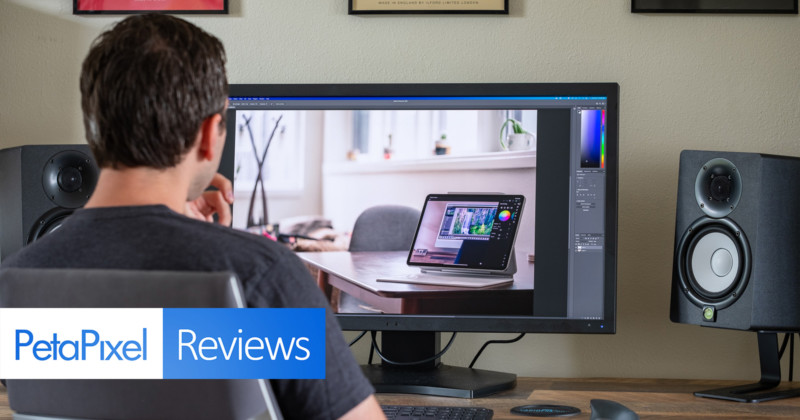
The Sharp NEC MultiSync PA311D is NEC’s flagship photo editing monitor, with more colors, more accurate colors, and more control over your colors than any other monitor we’ve tested to date. It’s not a perfect display — HDR editing is out of the question, and hardware calibration is impossible unless you pay extra for an NEC-branded colorimeter — but everything about this monitor was designed with professionals in mind, and we absolutely love that.
In recent years, there have been several entrants into the “color-accurate monitor” space, with companies like BenQ, ASUS, and Dell releasing displays with full coverage of the AdobeRGB color gamut, HDR capabilities, and built-in LUTs for proper hardware calibration. This has put the consumer department at storied brands like EIZO and Sharp’s NEC in a tough spot: the two make better professional products, but each are either unwilling or unable to spend the marketing dollars to explain exactly how and why to the uninitiated masses.
The companies seem to be relying on an established customer base, who already knows the how and why, and hoping that reputation alone will carry the brands to the younger generation of content creators.
In my humble opinion, this is not a winning strategy, but it does allow NEC the luxury of designing a product that makes exactly zero concessions to style over substance.
Design and Build Quality
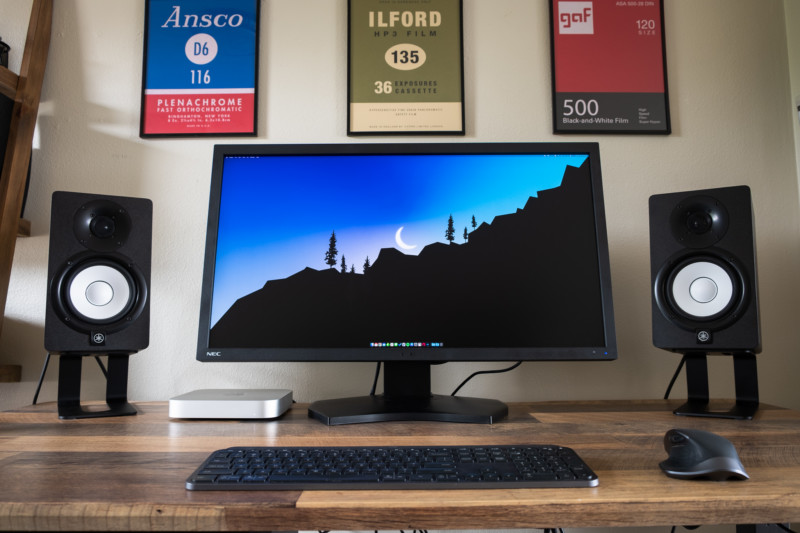
To quote the youths, the MultiSync PA311D is a “thicc boi.” This is a huge monitor that spends no time on frivolities like “thinness” or “not causing hernias when you try to lift it onto your desk.”
Joking aside, it’s obvious that NEC could not care less about tiny bezels, a stylish design, or a small footprint. The monitor itself is 3.1 inches thick, and it comes pre-mounted on a beefy stand that adds another 8.8 inches for a total depth of (*checks notes*) 11.9 inches when you’ve got it sitting on your desk. The whole thing is a thick plastic affair, with no consideration whatsoever for looks and a total weight of almost 33 pounds once you factor in the pre-attached stand.
The best word to describe the design sensibility of the PA311D is probably “utilitarian.” It’s your first hint that you’ve purchased a product designed for professionals by professionals.
Your second hint is the aspect ratio of the screen itself. The monitor boasts a true DCI 4K resolution of 4096 x 2160 which translates to a wider-than-normal 17:9 aspect ratio. As some productivity-focused monitors move the other direction—swapping their 16:9 aspect ratio 4K UHD (3840 × 2160) panels for taller 16:10 screens, the PA311D is more concerned with providing the appropriate aspect ratio for cinema video editing. Kudos deserved, and duly doled out.
The third and final bit of design that adds to the professional vibe is the input/output (I/O) selection, which is substantial. The PA311D boasts a total of five ports that can carry a 4K/60p 10-bit video signal: two DisplayPort 1.2 ports, two HDMI 2.0 ports, and one USB Type-C port with DisplayPort protocol that also features 65W charging. You also get a headphone jack and a USB Type-A hub with two upstream ports on the back of the device and three downstream ports on the side of the monitor. The USB Type-C port also acts as an upstream.
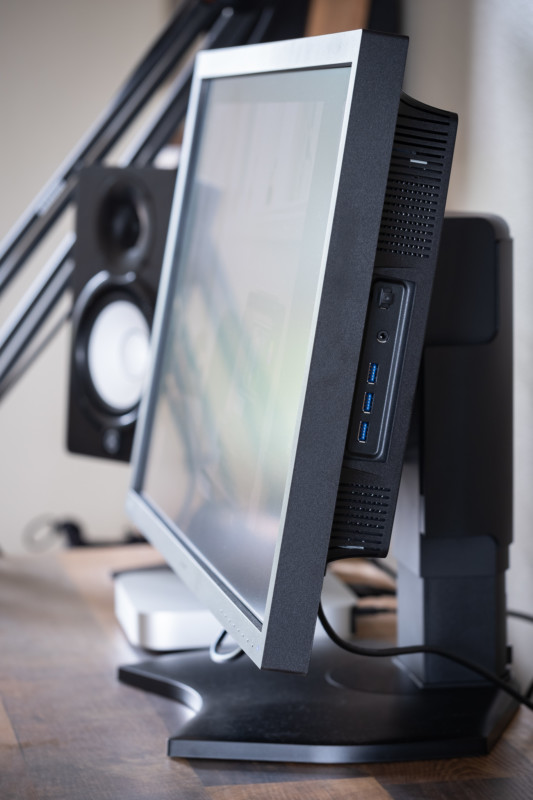
Notably missing is any sort of media card slot, but given the target audience, the omission sort of makes sense. If you’re at the point where you’re spending $3,000 on a monitor that was tailor-made for photo editing, you probably have your media ingestion workflow dialed in already.
Also missing from the PA311D is a built-in colorimeter, something that we’ve gotten used to in the high-end display space. Dell and EIZO both include them in their top-shelf displays, and Apple may soon turn every new iPhone into a pocketable colorimeter, but if you want to calibrate the 14-bit LUT that’s built into the MultiSync PA311D, you’ll need to pay extra for the “SpectralView II Display Color Calibration System” which is basically an XRite i1Display Pro with an NEC logo slapped onto the front and some bespoke software to match.
That bugs me, and it should bug you too, since hardware calibration is an absolute necessity for professional workflows, and even monitors without a built-in colorimeter usually allow you to use a third-party device to calibrate the internal LUT. But the difference between the PA311D on its own ($3,000) and the bundle that includes the Spectral View II software and the colorimeter ($3,250) is actually $10 cheaper than purchasing an i1Display Pro ($260), so at least there is that.
One final note on the design. The NEC PA311D does come with built-in speakers: two 1W tweeters arranged in stereo.
They are absolutely useless.
It’s the one thing I can point to and say: NEC wasted money including these. When it releases the next generation of this monitor, I sincerely hope that Sharp/NEC will leave these speakers out and include a colorimeter instead.
Gamut Coverage and Uniformity

The MultiSync PA311D’s gamut coverage, color uniformity, and (is this horse dead yet?) color control are all top-of-the-line. There’s no other way of putting it.
As NEC’s flagship, the PA311D does its best to cover both the DCI-P3 and AdobeRGB color gamuts, reaching an impressive 97% coverage of both when you set the profile to “full,” meaning the full panel gamut. This is difficult to do because of how the AdobeRGB and DCI-P3 gamuts are arranged in color space. Take a look at the CIE 1931 diagram with both color spaces represented by the white triangle (Adobe RGB) and the black triangle (DCI-P3):

In order to cover both of these, the display’s native panel gamut must be a triangle that is large enough to encompass both of the smaller triangles inside of it. This is why most monitors pick one or the other: monitors that cover exactly 99-100% DCI-P3 only cover about 84% of AdobeRGB, and monitors that cover exactly 99-100% of AdobeRGB only cover about 85% of DCI-P3.
The NEC MultiSync PA311D does its best to give you the best of both worlds, but it sacrifices a tiny bit from both color spaces in order to do so.
In our testing using an i1Display Pro Plus and the DisplayCAL software, we found that our review unit covers 97.9% of the AdobeRGB gamut and 97.3% of DCI-P3, all at a maximum Delta E 2000 of 1.26 with an average of just 0.3. Anything below a Delta E of 2 is considered invisible to the human eye.
This is excellent, and something you’ll rarely find in a monitor that costs less than $5,000.
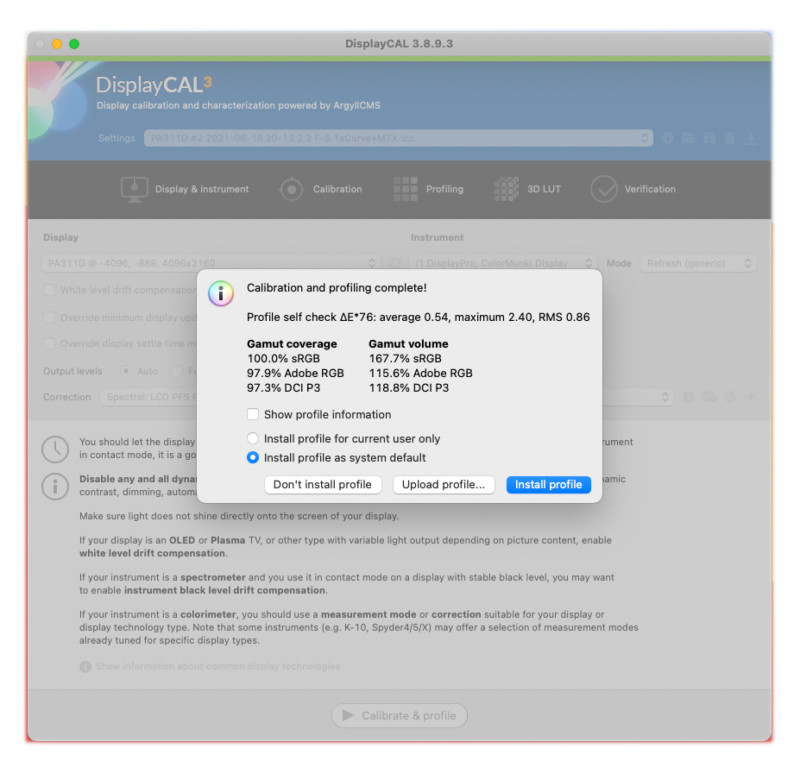

This standard of excellence extends to uniformity performance as well. We performed a laborious 9 x 5 patch test using DisplayCAL’s uniformity assessment and found that 42 of the 45 patches passed the recommended tolerance, with the remaining 3 patches drifting only slightly and passing “normal” tolerance.
With so much screen to try and light evenly, uniformity like this is phenomenal (click to view the full resolution PNG):
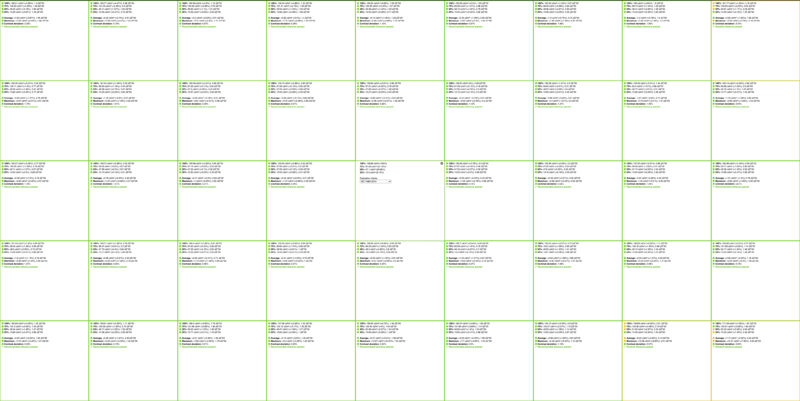
This top-shelf gamut coverage and uniformity is paired with extreme control over every aspect of your panel’s colors. Obviously overkill for most users, the MultiSync PA311D allows you to adjust the chromaticity coordinates—the exact (x,y) coordinates in color space (see above) where the Red, Green, and Blue primaries are mapped—of your display profile, as well as the white point and color temperature.
You can also adjust your gamma value, change the luminance of your display in actual cd/m2 units (none of this relative 0 to 100 business), and trim the hue, saturation, and offset (brightness) of your colors in six axes: Red, Green, Blue, Cyan, Magenta, and Yellow. And if that’s not enough, you can import your own 3D LUTs and printer profiles, which the monitor can emulate to the best of the panel’s abilities. There’s even a “compare” mode where colors that lie outside of the 3D LUT’s boundaries are shown in gray.
All of this is controlled by NEC’s SpectralView engine, which uses built-in sensors to monitor luminance, white point, ambient light, temperature, and the individual calibration of your display to “provide an unparalleled level of color control, uniformity, accuracy, and stability.” I usually avoid including a manufacturer’s own claims, but in this case, the reality reflects the marketing.
If this all seems like too much control, note that I’ve only scratched the surface here. There is a labyrinth of menus accessible both on-screen and through NEC’s MultiProfiler software that could keep you procrastinating for months while you tweak every little setting to your heart’s content.
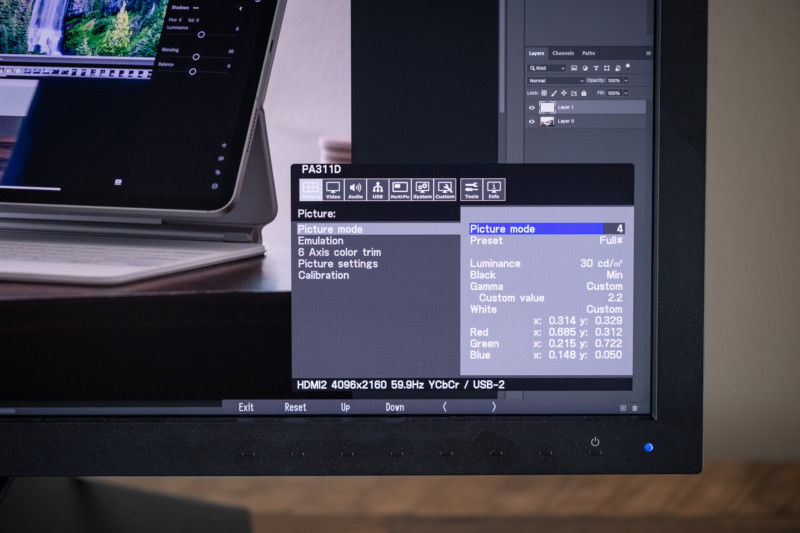
Seemingly the only thing the PA311D cannot do is properly edit or view HDR content. While there are HLG and PQ presets built into the display, the maximum brightness of 350 nits means that they’re not particularly useful. If you want to shoot and edit HDR content, you’ll need to buy a proper HDR monitor. That means ponying up an extra one to two grand on a Dell UP3221Q, Apple Pro Display XDR, or ASUS PA32UCG: all of these monitors feature sustained max brightness of 1000 nits with peak brightness even higher, earning them at least a VESA DisplayHDR 1000 certification.
The PA311D doesn’t even qualify for the shouldn’t-even-exist DisplayHDR 400 certification.
If you edit HDR video, this is definitely a con. I see it as a pro, because it allowed NEC to charge substantially less for an equally (or more) color-accurate monitor that is perfect for photo editing or regular cinema video editing. While photo editing in a proper studio environment, you should rarely (read: never) need to crank the luminance above 250 nits.
A Monitor with a Clear Purpose
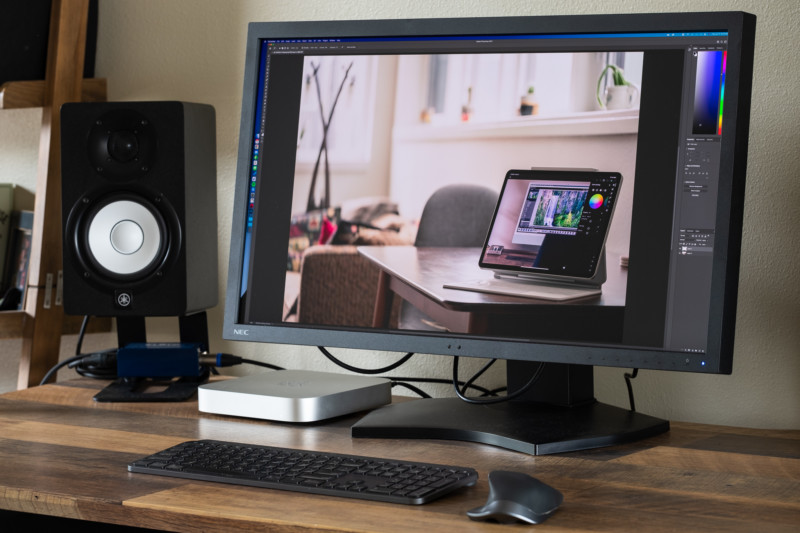
I often struggle to see what differentiates a truly “professional-grade” monitor from an enthusiast monitor with great coverage of AdobeRGB and/or DCI-P3, but the NEC MultiSync PA3221D makes this distinction crystal clear. To be sure, the gap has shortened significantly in recent years with companies like BenQ, ASUS, and Dell going after the creative market, but it’s not just about the large native panel gamut or a built-in LUT for hardware calibration. It’s not even about uniformity per se. It’s about control and consistency.
The PA311D lives and breathes color control, allowing you to select the precise chromaticity coordinates of your panel, adjust your monitor’s hue, saturation, and luminance in six axes, and ensure that all of your monitors are precisely calibrated to match one another. Once you’ve got it dialed in, the internal sensors continue to monitor the screen to make sure that it stays that way.
This level of control and consistency is a boon for photographers who don’t want or need to pay one to three thousand dollars more for a top-shelf HDR-capable display like Apple’s Pro Display XDR, ASUS’ ProArt PA32UCG, or Dell’s UP3221Q.
Pros
- 98% coverage of AdobeRGB and 97% coverage of DCI-P3 at the same time
- Phenomenal panel uniformity
- Extreme control over every element of your panel
- Built-in 14-bit LUT for hardware calibration
- DCI 4K resolution and aspect ratio
- Tons of I/O for connecting multiple video streams at once
- Built-in USB-A hub with three downstream ports and three upstream ports
- USB-C with DisplayPort protocol and 65W of power delivery
- Relatively affordable for such a high-end monitor
Cons
- Extremely thick and heavy design
- No built-in colorimeter
- No support for third-party colorimeters (you have to buy the NEC branded version)
- Not bright enough for HDR editing
- Built-in speakers are worthless
- Cannot hit 100% AdobeRGB or DCI-P3, because it tries to cover both at the same time
One item that I considered adding to the cons, but held off, was “you need to read the manual if you buy this monitor.” On the one hand, most modern high-end displays are so “plug-and-play” that it seems like a legitimate complaint; on the other hand, if you’re buying a MultiSync PA311D, you either know what the hell you are doing or you are very serious about learning. In that case, reading the manual doesn’t seem like an onerous task so much as performing your due diligence.
As I finished my review this week, I couldn’t help but feel that the Sharp NEC MultiSync PA311D is a dying breed of monitor. It is a professional-grade tool that makes no concessions to the amateurs and enthusiasts in the audience. It is, therefore, the antithesis of Apple’s “Pro” products that all too often sacrifice professional-grade control for a more seamless and beginner-friendly experience.
It’s a niche product, that much is obvious. But if you happen to be a part of that niche, it’s exactly the kind of monitor that you’ve been looking for.
Are There Alternatives?
I’ve mentioned three of this monitor’s best-known competitors a few times already, but the Dell UP3221Q, Apple Pro Display XDR, and ASUS PA32UCG or UCX monitors are all high-end, color accurate displays that are worth a look if your primary focus is video, and specifically HDR video. They are, however, much more expensive, because they put so much focus on hitting extreme peak brightness and maximizing contrast using full-array local dimming.
The more obvious competition for NEC’s MultiSync displays comes from EIZO’s ColorEdge monitors, but there is not an apples-to-apples competitor. The EIZO ColorEdge CS2740 is a 27-inch 16:9 4K IPS Monitor with a built-in colorimeter and 99% coverage of AdobeRGB, but it’s smaller than the PA311D and only covers 91% of DCI-P3. Meanwhile, the flagship EIZO ColorEdge CG319X is nearly identical—same 17:9 DCI 4K display, same max brightness, nearly identical advertised gamut coverage, plus a built-in colorimeter — but it costs nearly twice as much.
For this particular combination of specs, with this size and aspect ratio, there’s really no direct competitor to the NEC MultiSync PA311D.
Should You Buy It?
If you’re a member of the rarified class of professionals who will actually benefit from this level of color accuracy, and more importantly color control, then yes. This is a phenomenal monitor that delivers on all of its professional promises, especially if you pony up the extra $250 for the branded colorimeter.
Even photo and video enthusiasts, assuming they care more about performance than design and ease-of-use, will find that NEC charges much less than most of its main competitors for the same combination of core features.
The one group of users who really should steer clear are beginners. As tempting as it is to purchase professional-grade gear from the get-go, it will be ages before you can even begin to use this monitor to its full potential. It’s the same reason you wouldn’t point a beginner towards the Canon 1DX or Nikon D6. There are options out there that are smaller, lighter, and offer similar total gamut coverage for a fraction of the price. There are trade-offs, of course, but they’re trade-offs most users will never actually notice.